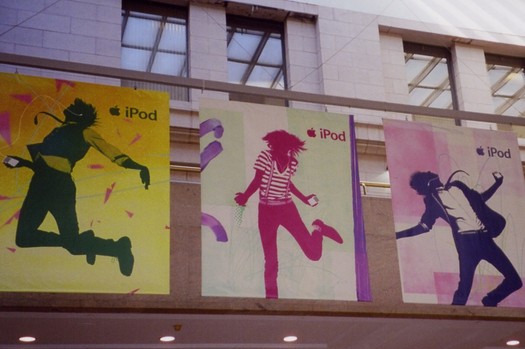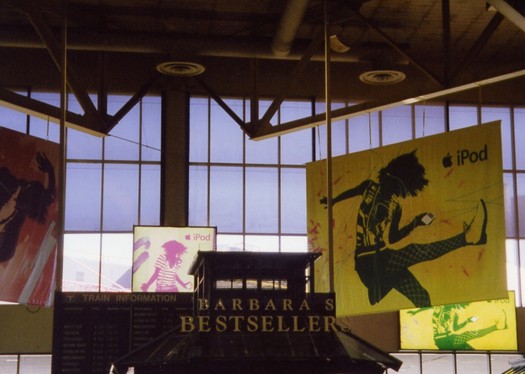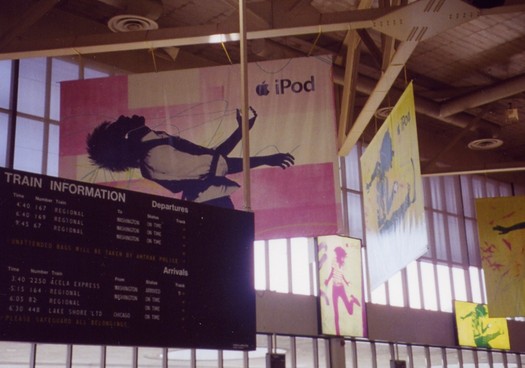
South Station, Boston, 2007
In Boston last weekend, I wandered into the most saturated advertising environment I have seen in the US, or anywhere else for that matter — saturated, in this case, by ads for a single product. In the city's South Station, a cunningly persistent advertiser has succeeded in insinuating no fewer than 114 of its sales messages into the concourse area among the book stands and fast food concessions. They dangle in the form of hanging banners behind the train departure information. They shine out above the track entrances from lightboxes. On either side of the station, 41 separate images on banners and panels plaster the walls above the ticket area and food court. Just when I thought I had scanned the entire station and run out of examples to count with a mounting sense of wonder at the penetrating power of the modern sales pitch, I found three more wall-mounted lightboxes tucked away in the far corners of the concourse.
Which brand do we have to thank for this unparalleled opportunity to contemplate the total coolness of its product — Samsung? McDonald's? Target? Not this time. Every single ad dancing across my sightline at South Station extolled the virtues of the iPod.

South Station, Boston, 2007
What to make of this? We might not appreciate advertising conducted like a saturation bombing campaign and we might even find this degree of repetition a shade boring if not totally manipulative, but we design enthusiasts do love and revere our award-winning Apple products fashioned by the sainted Jonathan Ive. And no Apple product is more loved, or celebrated, or used by a wider range of consumers than the iPod.
Does that make Apple's colonization of this or any other railway station acceptable? Only if you are prepared to go along with the idea that any promotional message can be rubbed into a captive audience's face to the point of overkill, and public spaces such as stations are fair game for any advertiser with the bucks and the gall to commandeer them. There is no difference when it comes to commercial intention between burgers, cellphones and nifty little music gizmos. Nor can the ever-increasing invasion of wall space and air space that might just look nicer without so many ads crammed into it be justified in terms of one perfectly legal product but not another.
What riveted my attention here, though, was the nature of the imagery that had colonized the concourse — its peculiar but revealing incongruity. Apple's latest campaign follows the pattern established by its previous efforts and shows iPod users dancing with the units they grasp in their hands. The latest batch of self-absorbed, pastel-colored groovers is more abandoned than ever. The young men and women throw their heads back as the ecstatic sound of whatever it might be possesses them like waves of electricity and shakes their bodies. They kick and jive and seem to float in a blissful zone among shapes and scribbles and washes of color. Their spiky iPod hair — they all frequent the same hairdresser — flails around prettily as they twist and rock. While their bodies and faces are still shown in silhouette, the better to pick out those pure white earpieces, the graphic pattern of their clothes semaphores their identity as members of the cool crowd. You have to wonder: doesn't anyone ever use iPods to listen to Appalachian folk music, Tibetan throat singing, or the occasional prelude by Shostakovich?

South Station, Boston, 2007
In the 1980s, when personal stereos were still new, many asked whether withdrawal from being fully present in the moment when out in public was a positive development. Listening in the street to music that only you could hear seemed to suggest a retreat from the idea of a shared community life into a private sanctuary with a "keep out" notice nailed to the door. As time passed, it became clear that many people were not as committed to the idea of a communal space for which everyone takes responsibility as had once been the case. The escalating presence of advertising in places that were previously off-limits for good reason only served to emphasize that there was nothing sacrosanct about the public realm, which advertisers were free to overrun and exploit for their own ends. This is not to say that personal stereos were the primary cause of these changes in public perception and conduct. But they were certainly indicative of the way that many people would increasingly treat public space as though it was an extension of their own private living area rather than a shared territory requiring a code of etiquette based on the presence of other people. (And in this regard, as we know, cellphones had an even greater impact on social behavior.)
Apple's South Station stunt appears to be part of a global push to maintain its position as leader in the competitive digital media player market. AppleInsider reports similar installations at the Gare Saint-Lazare in Paris and at the McGill subway terminal in Montreal. If the level of infiltration at South Street didn't look so ludicrous, and possibly even self-defeating, one might find its lack of proportion distasteful. As so often with advertising, there is a huge gap between the advertisers' fantasies of what they want us to do and what many of us actually care to do. Some people sitting at café tables or slumped on the benches waiting for trains were no doubt listening to personal stereos, but the prevailing pre-travel mood on the concourse was much closer to torpor than to the get-your-thing-on dance sensation unfolding above our heads in the iPod ads.
Yet now, to complicate things, the personal stereo is being used by some devotees as a way of reasserting spontaneity, exuberance and passion in heavily commercialized, over-controlled public places — with stations as a preferred venue. The phenomenon known as "flash mobbing" began in Manhattan in 2003. Hordes of conspirators show up at a pre-arranged time and location to take part in an unexpected but harmless activity such as pillow fighting. This soon evolved into "mobile clubbing" where, at the appointed hour, participants start dancing like deranged mime artists to a private soundtrack stored on their iPods and other mp3 players. "Mobile clubbing is a mirror image of a terrorist outrage," writes British novelist and critic Geoff Dyer, who took part in an event that made the news at Liverpool Street Station, London, in October 2006. "It's organized with similar precision, the feeling of conspiracy is palpable, and at the allotted time there is a detonation. Of joy."
So here, weirdly, is the very phenomenon that the congregation of airborne dancers in iPod's South Station takeover could be seen to depict. Just a coincidence or an opportunistic response to the latest international trend in street culture? As originally conceived, mobile clubbing was a soft, non-ideological form of protest, a public assertion of individual freedom and joie de vivre, which costs nothing, hurts no one, and amazes observers not taking part who happen to be in the area when bouts of crazy arm-waving and kick-stepping break out around them. "The point is that there is no point, we do it for fun, we do it because we can," explains Ben Cummins, an organizer. Everybody moves to their own beat, yet for a brief moment the dancers converge in a benign ceremony of collective celebration and delight. The action can't ultimately counter the solipsistic consumerism of the iPod and similar gadgets, on which it depends, but at least it's a sign of resistance to total self-involvement and a gesture towards reclaiming public space as a theater for undirected social action, no matter how transient.
The next London event is set to take place at 18:53 on 4 April at Victoria Station. Is it really possible, though, that those scheming cool hunters haven't already whispered into their masters' ears about the brilliant opportunity for guerrilla advertising and media coverage offered by engineering an apparently spontaneous mobile event?
Photographs: Rick Poynor
